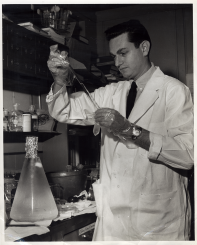“Almost the number of stars in the Milky Way.” Through this stellar comparison, the National Institutes of Health proudly announced in 2005 that the content of their computerized collection of DNA sequences called GenBank had reached 50 billion bases or units of DNA. Today, it contains far more, over 200 billion bases from over 350,000 different species, making it one of the largest scientific database in the world.
Here is the announcement of the availability of the Nirenberg papers: “GenBank & The Early Years of “Big Data”
http://circulatingnow.nlm.nih.gov/2016/03/03/genbank-the-early-years-of-big-data/
“Deciphering the Genetic Code: A 50 Year Anniversary” January, 2015
Marshall Nirenberg in the lab in early 1960’s, when he completed the first summary document of the genetic code — how triplets (DNA sequences) direct amino acids to form proteins. Pictures of the group and more about the papers are here:
http://circulatingnow.nlm.nih.gov/2015/01/21/deciphering-the-genetic-code-a-50-year-anniversary/

You must be logged in to post a comment.